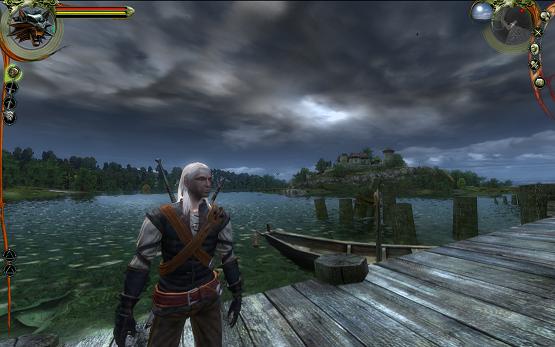
If you’ve ever felt that every fantasy RPG always rehashes the same generic tropes over and over again, then you might want to check out The Witcher. The first release of the game last year by its Polish makers at CD Projeckt suffered from numerous technical hitches and a Polish-to-English translation that sometimes left players scratching their heads. Thankfully, the newly released Enhanced Edition of the game, available as free download for customers who had bought the original, fixes many of these problems and includes extended and fully voiced translations, so RPG fans have no excuse to put off buying this gem, even if it is still a bit unpolished.
The game is based on the Polish book series of the same name by Andrzej Sapkowski and as such is set in a medieval fantasy world with a distinctively eastern European twist. It is a grim and dangerous place where at night simple folk bar their doors and huddle safe in their houses while monsters roam at will. The player takes on the role of one Geralt of Rivia, the most famous of the few remaining witchers in the world who are tasked with defending humanity from these monsters, for a fee of course. As the game explicity states, witchers aren’t noble knights in shining armour, and as you’ll soon learn over the course of this game, there’s no unalloyed good in the world since everyone, and I mean everyone, has an angle.
The game was made using a souped-up version of the Aurora engine that was used for Neverwinter Nights 2 and offers the same choice of playing from a top-down perspective or an over-the-shoulder view. The top-down view gives the player a better grasp of the tactical situation in combat but I would strongly recommend the over-the-shoulder view in order to make use of the full range of combat abilities available.
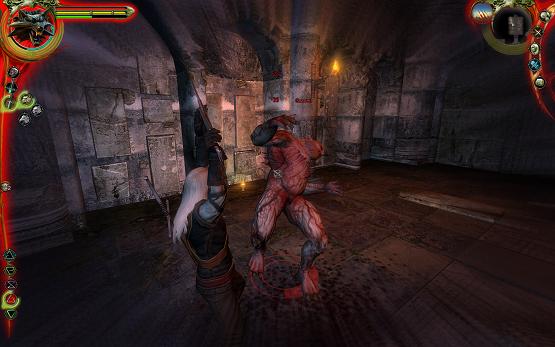
The Witcher uses a fairly unconventional combat system that will likely take some time to get used to. Clicking a mouse on an enemy causes Geralt to begin an attack sequence and at the end of the attack animation, the player has a small window of opportunity to click on the enemy again. Do it right and Geralt follows up with a second, and more damaging, attack. You can repeat this up to five times to create a combo string for optimal effectiveness. Being a skilled swordsman, Geralt will automatically parry and dodge attacks whenever possible without any input from the player, though in over-the-shoulder mode, you can roll away from enemies or even leap over their heads.
As a mutagenically-enhanced witcher who is faster and stronger than normal humans, Geralt usually has access to two swords and three combat styles for each, so there’s a total of six different melee options. The larger and heavier steel sword is more effective against humans, beasts and other non-supernatural enemies while the lighter silver sword is a necessity when fighting many types of monsters. The three different styles are the heavy style which is used against large, powerful enemies; the fast style against quick, agile ones; and the group style which is useful when Geralt needs to fight multiple enemies at the same times. While Geralt can pick up other types of weapons from fallen enemies, such as axes and flails, and wield them, there’s not much point in doing so because those weapons aren’t compatible with the witcher combat styles.
All this makes combat in The Witcher more engaging and actioney than most RPGs and since you’ll want to switch to the optimal sword and style for different enemies, sometimes even in mid battle, it feels tactically rich as well. It’s neat from a game design perspective and instantly makes the combat more enjoyable but I’d argue that it feels a bit unrealistic at times. It can seem incongruous that you can kill swathes of drowners using the group style but when only one is left the previously devastating group style attacks suddenly become completely ineffective.
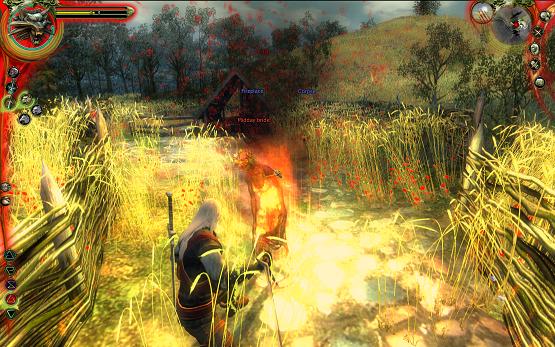
Geralt also has a variety of magical abilities, called Witcher’s Signs, that can be useful in combat. The Igni sign for example can burn enemies and set them on fire, while the Aard sign can be used to knock them down and disarm them. When things get rough, Geralt can quaff potions, throw bombs or coat his swords with special oils to even the odds. The potions are absolutely necessary at the highest difficulty level and can do everything from accelerating your healing factor to vastly boosting your reflexes, making it seem as if the whole world is slow compared to you. The bombs are a minor option which I mostly skipped, allowing you to poison a group of enemies or send them scurrying away in fear. Oils too, come in a variety of types. A silver sword coated in Vampire Oil, for example, is far more effective against various types of vampires, while one coated in Spectral Oil is good against spectres, wraiths and other ghostly beings. As you might guess, a big part of the game is researching monsters from books and scrolls to find out what sword styles and oils they are vulnerable to and adapting your tactics accordingly.
These tools are crafted from ingredients foraged from plants and fallen enemies, so if you enjoyed gathering herbs and flowers in Oblivion, you’re in for a treat here. Character progression is handled by assigning talents to enhance various abilities. You’re awarded a certain number of talent points each time you gain a level and defeating special boss monsters and making potions from the ingredients they drop can give you additional points or even unlock previous unavailable talents.
Where the game really shines and makes it mark however is its story and setting. Geralt has inexplicably returned from the dead just as a mysterious band of bandits led by a mage launches a raid on the ancient witcher stronghold of Kaer Morhen. The mage manages to escape with the secret processes that the witchers use to enhance their abilities at the cost of being forever sterile and Geralt must pursue them and recover those secrets. The quests along the way are complex and varied. One memorable quest chain has Geralt investigating a list of suspects to determine which of them are working with the bandits, and involves performing an autopsy, interrogating suspects and noticing clues in their homes. Many of the quests are interlinked in an organic way. Solving a quest one way might open up a solution to another quest in an unexpected way. In many other RPGs, quest givers seem to merely exist to dispense a quest and after you hand it in, cease to exist for all intents and purposes. Not so in The Witcher, where the choices you make even at the very beginning of the game, including who you choose to kill and who you choose to allow to live, continue to matter even up to the end of the game. There are times when it seems that the game has forgotten a loose thread from a quest only have it reappear a few chapters down the line.
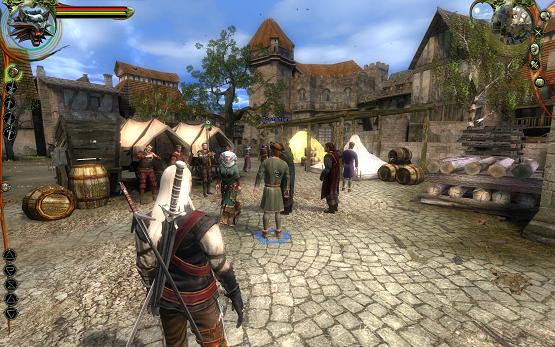
Quest solutions are rarely entirely good. In a world in which everyone is guilty of something or other, Geralt is often forced to choose the lesser of two evils. Elves in this game, for example, are portrayed as terrorists willing to indiscriminately kill human women and children in their futile war against the dominion of mankind while human knights are fanatic and bigoted zealots who tread on the rights of nonhumans at every opportunity. Even Geralt himself never slays monsters out of charity and asks for money, goods or even sexual favours in exchange. The characters that you meet constantly lie to you and keep all sorts of nasty secrets. One man who claims to love a young girl turns out to have raped her in a fit of lust causing her to commit suicide, for example. This allows the story to go places and examine aspects of human life that no game that isn’t similarly M-rated can do. Geralt’s journey is an engrossing and emotionally powerful one, but even the end is a cruelly pyrrhic victory.
This prevailing darkness is reflected in the game’s graphics. CD Projeckt has done a amazing job with the engine. The landscape is gorgeous and the cities full of detail and life. But this is more a world of gothic horror than high fantasy. The sky is constantly overcast and it rains often, sending people scurrying for cover. Houses are often in disrepair, with gardens and graves overgrown by weeds, and signs of ruin and decay are everywhere. In the daytime, ordinary folk go about doing mundane, everyday jobs, washing laundry, picking fruits from bushes, complaining about the tough times. At night, the guards prowl the streets, torches in hand, and are often beset upon by monsters and bandits. In the same way that Stalker sucessfully captured the haunted look and feel of Chernobyl, you might say that The Witcher presents a grim, realistic view of the tough lives of ordinary folk living in age where monsters really do exist.
Several flaws mar the finished product. While the Enhanced Edition has significantly cut down on the loading times that were the main source of annoyance for many players, the game still crashes far too often, frequently corrupting save games in the process. Numerous cutscenes take away control from the player, and while these do a great job of telling the story, they often return control to the player at very inopportune moments, for example while Geralt is surrounded by enemies and his sword is sheathed, causing many frustrating deaths. Combat difficulty is all over the map. Some boss enemies seem scary but turn out to be pansies while other enemies are so hard as to make some players quit in frustration. While the graphics are generally good and movements are well animated, sometimes the animations become desynchronized such that Geralt floats rather than runs over surfaces. I think that the game is good enough to put up with these problems but I can understand if players quit due to the game crashing too much.
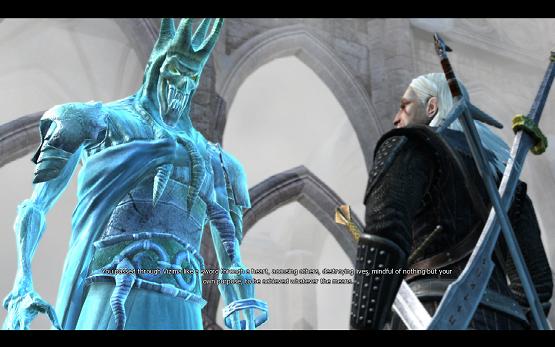
It’s pretty clear that this game isn’t for everybody and parents are well advised to keep their children clear from it. But if you’re one of those who keep complaining that all fantasy RPGs are always the same, well, The Witcher makes for the perfect counter-argument. Here’s to more mature RPGs from developers from eastern Europe!
Aw!
Your review made me wanna try out this game!
But you mentioned that the original copy sold in Malaysia is the censored version yah?
The version sold in Malaysia is definitely censored, but I don’t think it’s a big deal. Other than the sex cards, which you’ve seen already, I believe that a few character meshes were changed. In the original version, a couple of the female NPCs are completely naked but in the version I played, they’re still naked but their hair is artfully arranged to cover the, ah, more sensitive parts.